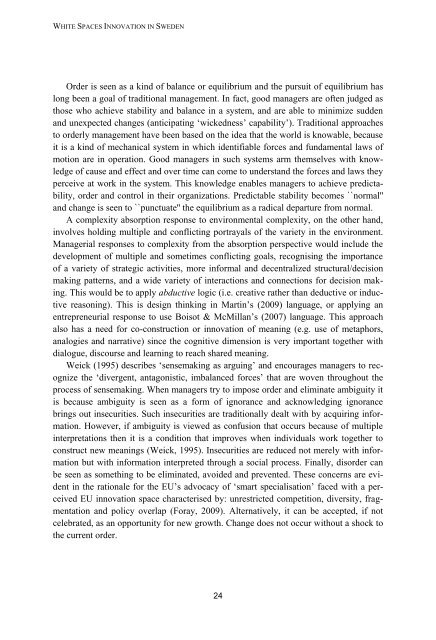White Spaces Innovation in Sweden - Innovation policy for ... - Vinnova
White Spaces Innovation in Sweden - Innovation policy for ... - Vinnova
White Spaces Innovation in Sweden - Innovation policy for ... - Vinnova
You also want an ePaper? Increase the reach of your titles
YUMPU automatically turns print PDFs into web optimized ePapers that Google loves.
WHITE SPACES INNOVATION IN SWEDENOrder is seen as a k<strong>in</strong>d of balance or equilibrium and the pursuit of equilibrium haslong been a goal of traditional management. In fact, good managers are often judged asthose who achieve stability and balance <strong>in</strong> a system, and are able to m<strong>in</strong>imize suddenand unexpected changes (anticipat<strong>in</strong>g „wickedness‟ capability‟). Traditional approachesto orderly management have been based on the idea that the world is knowable, becauseit is a k<strong>in</strong>d of mechanical system <strong>in</strong> which identifiable <strong>for</strong>ces and fundamental laws ofmotion are <strong>in</strong> operation. Good managers <strong>in</strong> such systems arm themselves with knowledgeof cause and effect and over time can come to understand the <strong>for</strong>ces and laws theyperceive at work <strong>in</strong> the system. This knowledge enables managers to achieve predictability,order and control <strong>in</strong> their organizations. Predictable stability becomes ``normal''and change is seen to ``punctuate'' the equilibrium as a radical departure from normal.A complexity absorption response to environmental complexity, on the other hand,<strong>in</strong>volves hold<strong>in</strong>g multiple and conflict<strong>in</strong>g portrayals of the variety <strong>in</strong> the environment.Managerial responses to complexity from the absorption perspective would <strong>in</strong>clude thedevelopment of multiple and sometimes conflict<strong>in</strong>g goals, recognis<strong>in</strong>g the importanceof a variety of strategic activities, more <strong>in</strong><strong>for</strong>mal and decentralized structural/decisionmak<strong>in</strong>g patterns, and a wide variety of <strong>in</strong>teractions and connections <strong>for</strong> decision mak<strong>in</strong>g.This would be to apply abductive logic (i.e. creative rather than deductive or <strong>in</strong>ductivereason<strong>in</strong>g). This is design th<strong>in</strong>k<strong>in</strong>g <strong>in</strong> Mart<strong>in</strong>‟s (2009) language, or apply<strong>in</strong>g anentrepreneurial response to use Boisot & McMillan‟s (2007) language. This approachalso has a need <strong>for</strong> co-construction or <strong>in</strong>novation of mean<strong>in</strong>g (e.g. use of metaphors,analogies and narrative) s<strong>in</strong>ce the cognitive dimension is very important together withdialogue, discourse and learn<strong>in</strong>g to reach shared mean<strong>in</strong>g.Weick (1995) describes „sensemak<strong>in</strong>g as argu<strong>in</strong>g‟ and encourages managers to recognizethe „divergent, antagonistic, imbalanced <strong>for</strong>ces‟ that are woven throughout theprocess of sensemak<strong>in</strong>g. When managers try to impose order and elim<strong>in</strong>ate ambiguity itis because ambiguity is seen as a <strong>for</strong>m of ignorance and acknowledg<strong>in</strong>g ignorancebr<strong>in</strong>gs out <strong>in</strong>securities. Such <strong>in</strong>securities are traditionally dealt with by acquir<strong>in</strong>g <strong>in</strong><strong>for</strong>mation.However, if ambiguity is viewed as confusion that occurs because of multiple<strong>in</strong>terpretations then it is a condition that improves when <strong>in</strong>dividuals work together toconstruct new mean<strong>in</strong>gs (Weick, 1995). Insecurities are reduced not merely with <strong>in</strong><strong>for</strong>mationbut with <strong>in</strong><strong>for</strong>mation <strong>in</strong>terpreted through a social process. F<strong>in</strong>ally, disorder canbe seen as someth<strong>in</strong>g to be elim<strong>in</strong>ated, avoided and prevented. These concerns are evident<strong>in</strong> the rationale <strong>for</strong> the EU‟s advocacy of „smart specialisation‟ faced with a perceivedEU <strong>in</strong>novation space characterised by: unrestricted competition, diversity, fragmentationand <strong>policy</strong> overlap (Foray, 2009). Alternatively, it can be accepted, if notcelebrated, as an opportunity <strong>for</strong> new growth. Change does not occur without a shock tothe current order.24
















